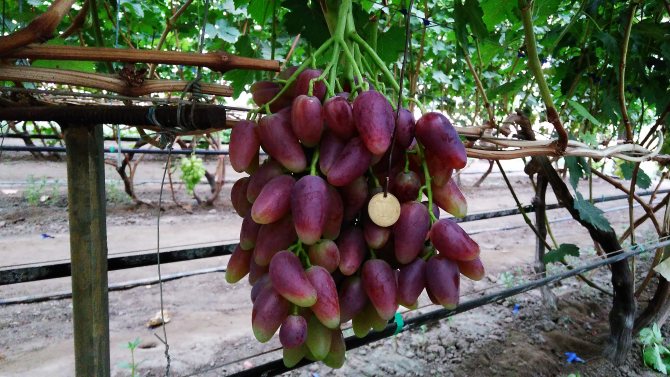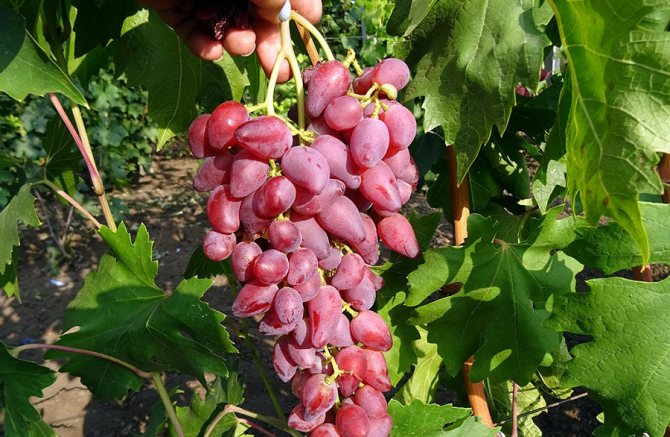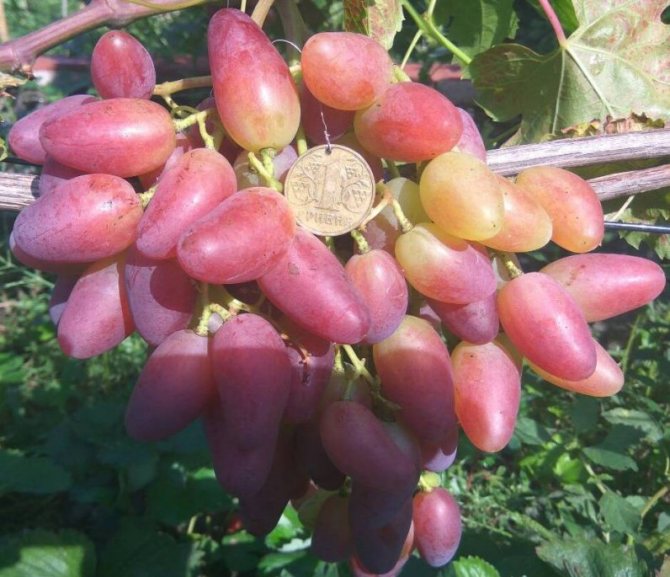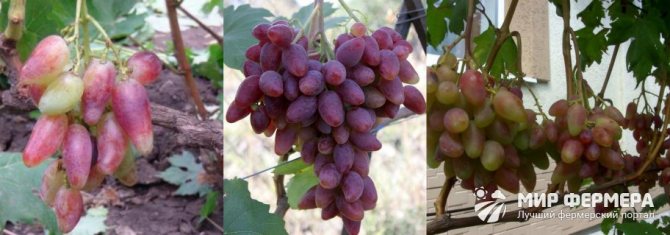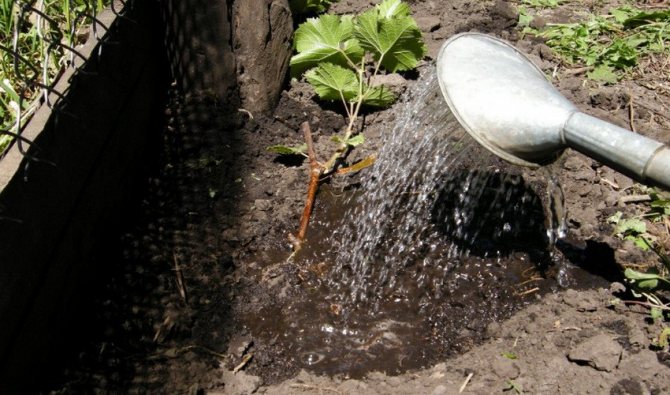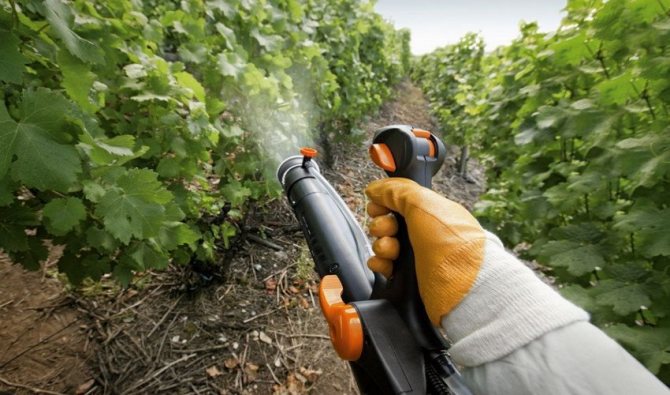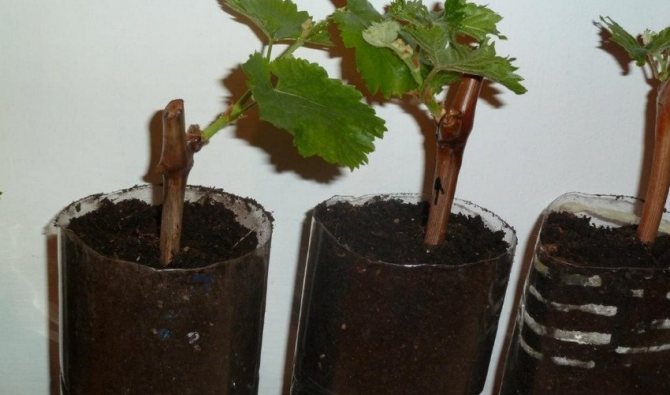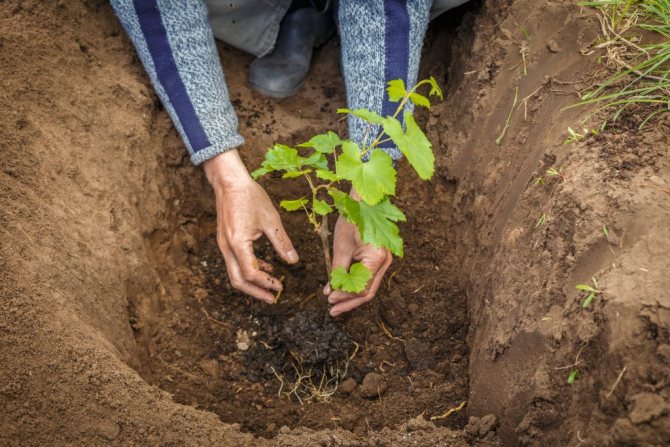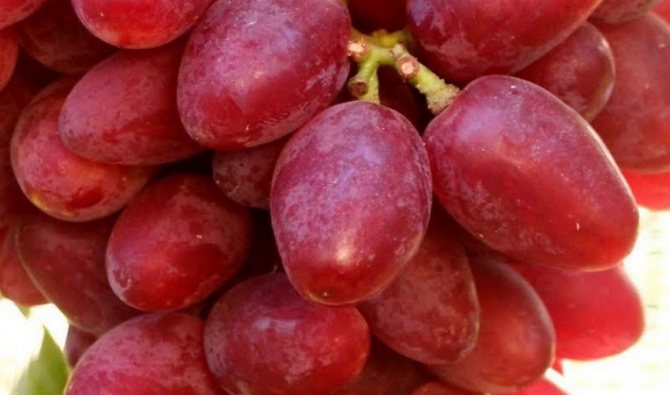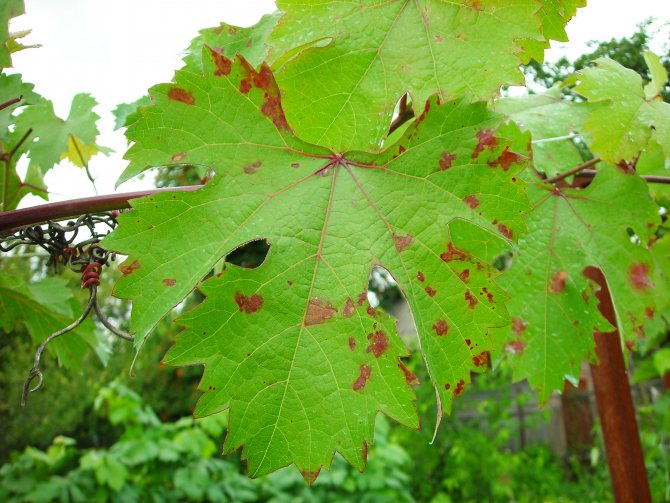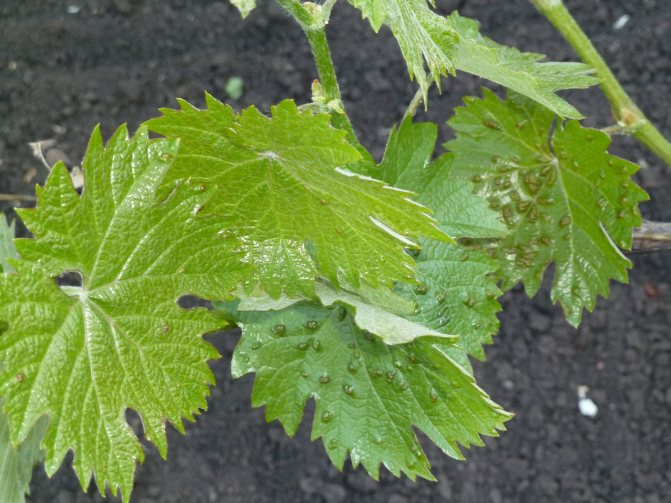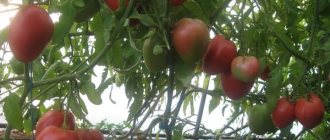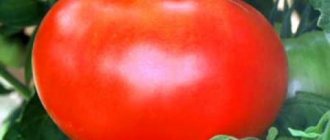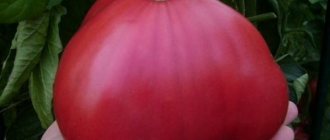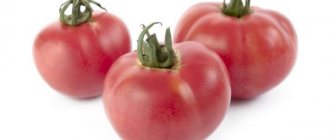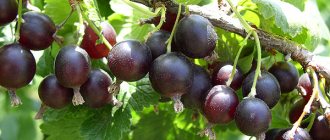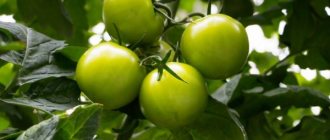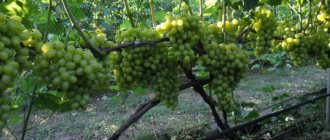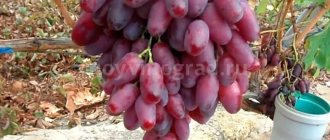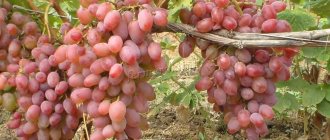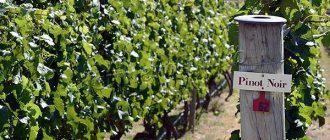Among the numerous grape varieties on the modern market, Dubovsky pink is considered relatively young, but this does not reduce its popularity at all. The fact is that this hybrid has excellent taste and high yield, but at the same time it is absolutely undemanding to care.
In today's article, we will give a detailed description of the variety, its pros and cons, as well as the basic rules for planting and caring for young seedlings and an adult fruiting vine.
Where did it come from?
The grape variety "Dubovsky" comes from the village of Dubovka (Volgograd region), where breeders carried out their work. From this, in fact, the name of the variety came. In the village of Dubovka, a breeder, Sergei Eduardovich Gusev, worked, who bred this unusual variety. Gusev's grape "Dubovsky Pink" is a cross between two varieties Red Delight and Novocherkassk Jubilee.
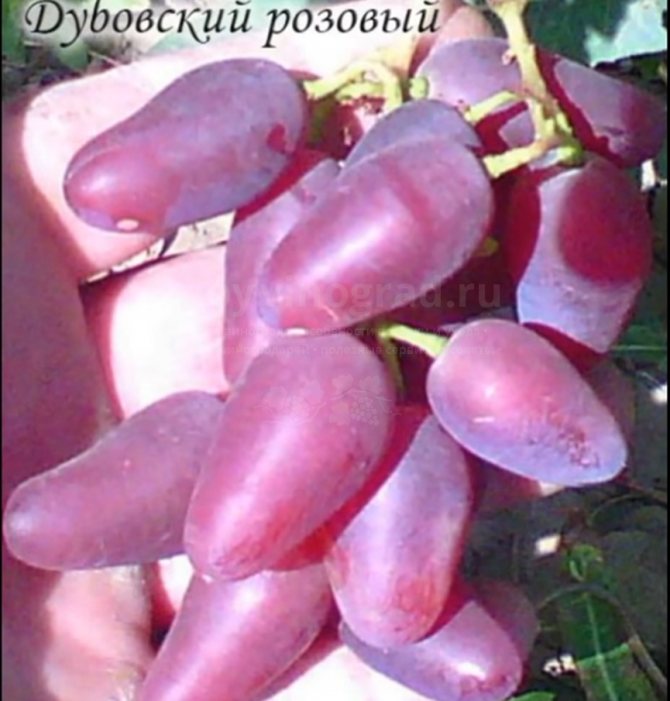
Harvesting and storage
The harvested grapes can be stored for a long time in the refrigerator or cellar. It is important to ensure air circulation in the room and remove overripe berries. Dubovskiy pink belongs to the varieties suitable for transportation.
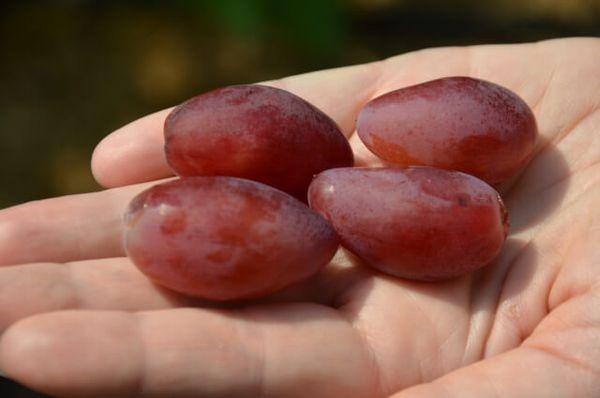

Harvesting begins in the second half of August. The formation of a re-crop on young shoots during the season is possible.
Description of grapes Dubovsky Pink
The appearance of Dubovsky grapes is very unusual. This grape variety can be defined as a giant. This is because at first glance, one can immediately notice large bunches of grapes and an atypical brush shape. The bunch of grapes "Dubovsky" has the shape of a cone, due to the different arrangement of the berries and their external uniqueness, so the brush looks very sloppy and disorderly. One bunch of pink grapes can weigh from 1 - 1.5 kilograms, which is a lot in comparison with other varieties.
The berries on the cyst are also large. The weight of one fruit can reach 20 grams, while having about 6 centimeters in length and up to 3 centimeters in width. The shape of the fruit is unusual: it is elongated and conical, towards the end the fruit tapers and the tip bends to the side. The grapes have a very bright pink color, often a reddish tint prevails in the color of the fruit, which makes the bunch even more visually juicy and bright. Sometimes the Dubovsky Muscat grape has a vine that takes on a reddish tint.
Agrobiological characteristics
In own-rooted culture and grafted on vigorous rootstocks, bushes of this variety are distinguished by rapid and powerful development. The crown of a young shoot is smooth, shiny, green with a noticeable bronze tint, without pubescence. The leaves of Dubovsky pink are large in size, rounded in shape, openwork, deeply dissected into five lobes. The notches between the lobes are closed with a rounded gap, or open lyre-shaped with a narrow mouth and a rounded bottom. The petiole is open, of medium width, with parallel sides and a flat bottom. The surface of the leaf blade is smooth, there is no pubescence on the underside. The teeth along the edge of the plate are large, saw-shaped, with smooth edges and sharp tops. The flower is bisexual, does not show problems with pollination. The grapes are not prone to peas and excessive loosening of the clusters. The maturation of one-year growth occurs without problems and along the entire length.A well-ripened vine is capable, according to the author, of tolerating frosts down to -24 ° C. There is no objective data on this yet, so the growers are reinsured by covering the bushes for the winter.
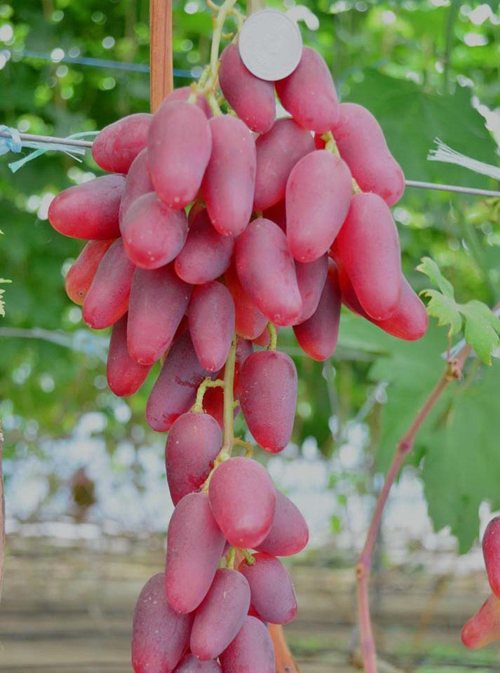

The bunches of Dubovsky pink are very large in size, their mass on an adult bush starts from one kilogram, and on average they weigh 1.2-1.5 kg, conical in shape, moderately dense, impressive and very attractive in appearance. The comb is strong, can easily withstand weighty brushes, light green in color. The berries in a bunch are located freely, do not deform. They are excellent in size and shape - up to 60 mm long, up to 30 mm in diameter, elongated, conical, with an original curvature of the tip. The weight of the berries reaches 20 grams, while the average weight is in the range of 14-15 grams. They are painted in an elegant pink color, in many respects repeating the colors of the Novocherkassk Jubilee variety. In different climatic conditions, shades of color can vary from light golden pink to very saturated. The pulp of the grapes is also pink in color, crisp in consistency, juicy, with a pleasant taste, but without specific notes in the aroma. The sugar content of the berry juice is high, "vostorgskaya" - 21 grams / 100 cubic cm. There is no data on acidity, but according to taste, the ratio of acid and sugar is very harmonious. The skin is thin, moderately strong, practically not felt when consumed. The wax coating on the skin is light, medium intensity. There are very few seeds - one, sometimes two, and in a large volume of berries they occupy a scanty part. The tasting score of Dubovskiy pink, shown in the first years of the state test, was 9.3 points.
The grape harvest is successfully used for fresh consumption. Today, the bunches of this hybrid form can be called one of the most attractive and demanded on the market, due to the original appearance and large-fruited. Even the magnificent representatives of the famous "Krainov's troika" look somewhat faded next to Dubovskiy pink. Its only drawback is the side effect of its main advantage - giant bunches weighing one and a half to two kilograms do not always find their buyer, and even eating them at one time seems problematic. Suitability for long-distance transportation and long-term storage of the variety is average due to the rather thin skin, which is also a certain cost of the high taste of grapes.
Ripening of the crop occurs very early. The growing season from bud break to the onset of ripeness of berries is 105-115 days. In the south, the first bunches can be cut at the beginning of August. The total amount of heat required for maturation is 2300-2350 ° C (SAT). Thanks to this, Dubovsky pink is quite capable of being cultivated in the northern regions with a relatively short and cool summer. Cleaning in this case will shift to late August - early September.
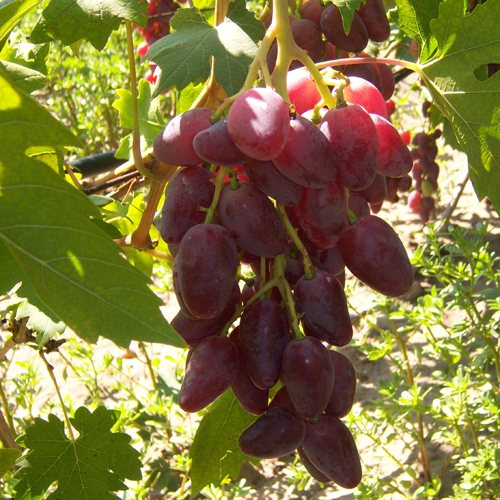

The grapes begin to bear fruit very early - in a self-rooted culture a year after planting. The yield of the variety is high, the first growers who received full harvests testify to the productivity of at least 10 kg per bush. The average number of clusters per fruitful shoot is close to two, which is why the hybrid is classified as prone to overload. In addition, it has a high ability to plant a second crop on stepchildren, which in the south ripens successfully in autumn, but lags far behind the main crop in terms of large-fruited.
After the onset of removable maturity, clusters of Dubovsky pink can continue to hang on the bushes without a high risk of cracking or decay. Many pioneers of the variety confirm its resistance to this kind of damage even in unfavorable seasons for ripening conditions.At the same time, it is necessary to provide protection from wasps for the bunches of grapes, since due to the thin skin of the berries, these pests can cause significant damage to the ripening crop.
Features of the variety
The red Dubovsky grape has some features that should be taken into account if you want to breed this variety. The berries on the branch remain green for a very long time. Despite the time that they ripen and the impressive size they reach, the berries are in no hurry to acquire a different color. They can remain green for a very long time, but after, when the right time comes, in a matter of days they can acquire a juicy pink-red color, which is a signal that the berries are ripe and can be harvested.
The grape variety "Dubovsky" passed the main tasting excellently and received 9.3 points out of ten.
The grape "Dubovskiy rosy" undoubtedly has a pleasant, sweet taste with tangible notes of nutmeg. The flesh of the berries is very juicy, but crispy. There are few seeds in it, a maximum of 2 large pieces per one large fruit. The sugar content in grapes of this variety is about 23%. The berries are firmly attached to the branch, and during transportation they do not crumble, and the bunch remains as attractive and whole as when harvesting. This variety combines amazing taste, high fertility, as well as weather resistance and unpretentiousness. The plant can withstand up to -24 degrees of frost. Also, this hybrid perfectly tolerates a long drought or heavy rains.
Pros and cons of the variety
In the absence of pronounced disadvantages, Dubovsky Pink is characterized by a number of advantages:
- decorative appearance of plants;
- stunning harvests;
- high quality fruits (beautiful appearance, large size, excellent taste, shelf life and transportability);
- unpretentiousness to weather conditions;
- high index of frost resistance;
- invulnerability to a number of diseases.
Among the shortcomings, it was revealed that sometimes the variety can suffer from oidium and wasps raids.
Care rules and landing
Due to its unpretentiousness and taste, this grape variety began to be bred everywhere, especially in the northern regions, where other varieties simply freeze out due to cold weather conditions and die. But before you start growing pink "Dubrovsky", you should know some rules for the care and planting of this type of grape.
- Seedlings of grapes "Dubovskiy pink", when multiplied, can begin to fully bring the harvest two years after planting.
- There are no particular difficulties in planting cuttings, you just need to know some tricks.
- The best time to plant cuttings in the ground is autumn or early spring. At this time, all the sun's heat accumulates deep in the soil and the likelihood that the seedlings may not take root drops sharply.
- In order to get a harvest for the first year, it is necessary to plant grape cuttings "Dubovsky" in early spring on a vine that has long been planted with a good, overgrown root system. The vine can be from any grape, as long as it is healthy.
- It must be remembered that the vine should be pruned for high-quality fruiting. Standard pruning for 6-8 eyes. Perhaps due to the fact that the grape clusters are large in mass, you will need to tie up the vine for better growth.
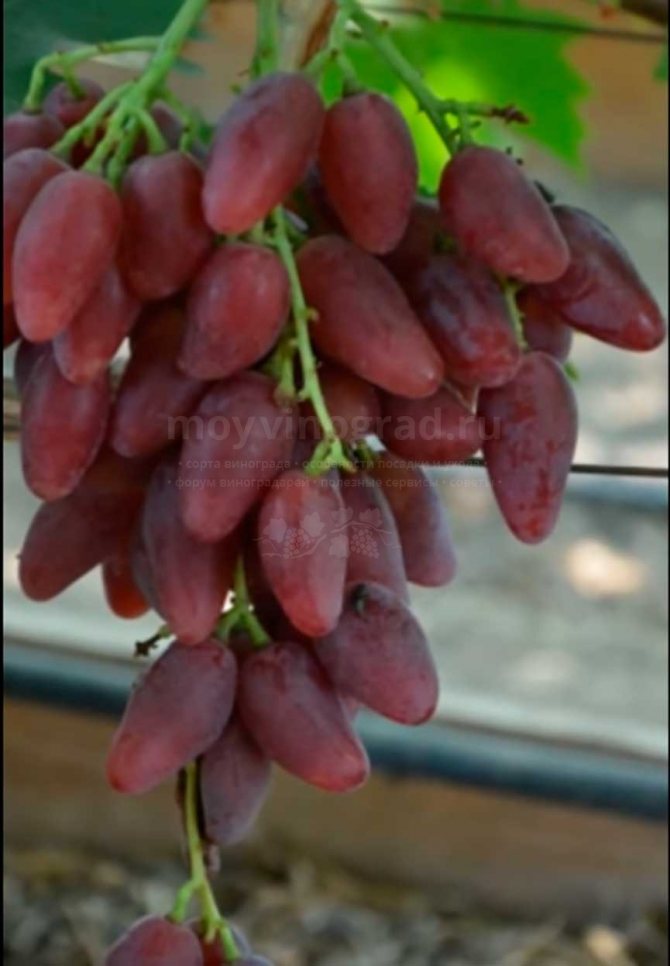

Districts and features of cultivation
It is preferable to grow the Dubovsky pink variety in regions with a warm climate (southern part of Russia, the Volga region). The point is not only in the air temperature, but also in the fact that the composition of the soil is the most suitable there. And this criterion is very important for this grape. The soil in these areas is fertile and loose, filled with nutrients.
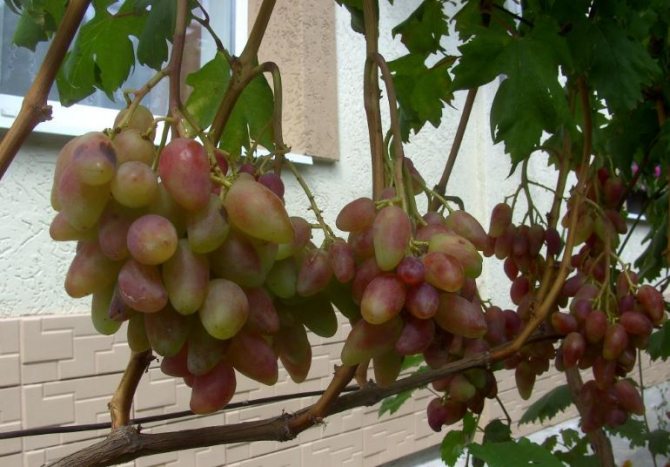

Ripening of grapes Dubovsky
The amount of precipitation that falls in the season is also important - it should be in moderation, but if the rainy summer affects only the vine and leaves, then a prolonged drought can completely destroy the entire crop.
Diseases
Since the variety was bred recently, there is not so much information about diseases, resistance to pests, as would be desirable for ordinary gardeners and already experienced winegrowers. Every year, the study of "Dubrovsky" is moving forward several steps, the vitality of the pink variety is very pleasing to the breeders. Based on the studies already carried out on this variety, it can be argued that "Dubrovsky pink" is rarely, but susceptible to such a disease as oidium. With this disease, certain procedures must be carried out so that the plant does not die and bears fruit in the future. Sulfur particles are captured by a fungal infection and converted into hydrogen sulfide, which is detrimental to the vine, and only after that to the plant as a whole. With such an ailment, a sulfur preparation can perfectly cope, which will replenish the supply of the missing element and be able to remove a fungal infection.
Another enemy of this pink grape is insects, especially wasps. Due to the fact that grapes have a high percentage of sweetness, wasps have boundless love for them. If you do not take any measures to combat these insects, then you can lose half of the harvest, because the wasps will happily enjoy the fruits of your grapes. To protect the bunches from unwanted pests, some resourceful gardeners place a bunch of grapes in gauze cases that can be easily made with their own hands. This device will protect the berries from the invasion of wasps and leave them whole.
It is also recommended to spray the plant with vinegar about twice a month, or to hang an open container next to it, in which the beer should be poured. These measures must be taken to ensure that your plant is healthy, and the fruits are beautiful and juicy.
How to plant correctly
The future harvest of the new grape hybrid depends on the observance of agricultural technology. It is important to comply with the landing dates, choose the right site and prepare the soil.
Timing recommendations
Grape seedlings are planted in spring or autumn. Young bushes should form a good root system during the season in order to withstand the coming frosts.
Depending on the region, spring planting can be carried out from the end of March, autumn planting from the end of September. Often, planting pits are prepared and formed in advance, for spring planting in the fall, in the spring for autumn planting.
Site selection and preparation
The plot for successful cultivation of grapes must be well lit, the southern or southwestern slope is optimal.
In lowlands and wetlands, grapes are not planted. Stagnant moisture at the roots is detrimental to plants; it is recommended to install drainage at the bottom of the planting pit. When planting, organic and mineral fertilizers are applied, they moisturize the soil well.
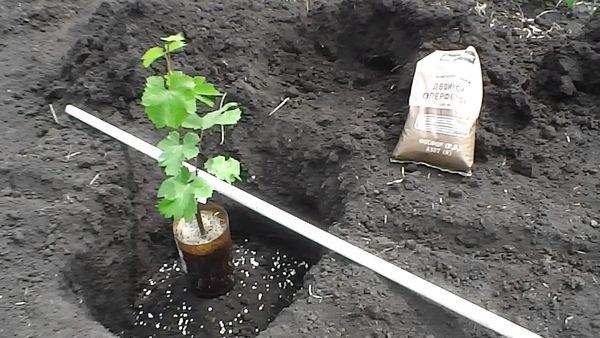

How to choose and prepare planting material
When choosing planting material, attention is paid to the presence of signs of fungal infections. The root system must be well developed. It is recommended to purchase seedlings with a closed root system and grafting. The buds must be alive, the stem intact.
Before planting, the seedling is watered abundantly. You can disinfect the plant and soil by spraying with a solution of potassium permanganate.
Landing scheme
The hole must be at least 80 centimeters deep and about 1 meter in diameter. The distance between the bushes is maintained at 3 meters. In this case, the plants should not interfere and shade each other. Chess planting of grape bushes is practiced.
Using
Many people call the grapes "Dubovskiy pink" the best hybrid among various grape varieties in recent years.This grape variety is used for pressing and juice production. It contains a lot of useful substances, and the juice perfectly quenches thirst even on the hottest day. Dubovski grapes are also dried. Raisins from this variety are large and very sweet. It is used in confectionery, cottage cheese, or simply sold by weight. A good wine is obtained from this variety, which has a tart aroma of nutmeg, a deep smell of wood chips mixed with light currents of flowers. But most of all this variety is used fresh. "Dubovsky" in an instant leaves the shelves of fruit shops. Based on this, it can be argued that it is very popular, and its juicy and sweet berries are madly in love with customers.
Bears fruit in the northern regions
Characteristics:
| Grape pink | |
| |
| general characteristics | Versatile varieties, vigorous |
| Ripening period | Vegetation period 90 - 160 days |
| Taste | 7.1 points (out of 10) |
| Weight | Berries from 3 to 6g, brush 0.2-2 kg |
| Fruiting | Self-pollinated, forms bisexual flowers |
| Winter hardiness | from minus 23 to minus 30 ° C depending on the variety |
| Pests and diseases | Resistant to mildew, gray mold and powdery mildew |
- Pink grape varieties are most in demand among gardeners and winegrowers. in all regions. The main reason is high technical characteristics, high yield even in the northern regions.
- Pink grapes have the highest sugar content: from 23%, excellent taste. In 80% of varieties, bisexual flowers bloom, which completely solves the problem of pollination.
- Compared to other species, the best fruiting percentage up to 1.7. The berries are very large, from 3 cm in length and from 2 cm in width, sweet, juicy.
- Pink varieties are resistant to the most common diseases and peststhat can completely destroy vineyards.
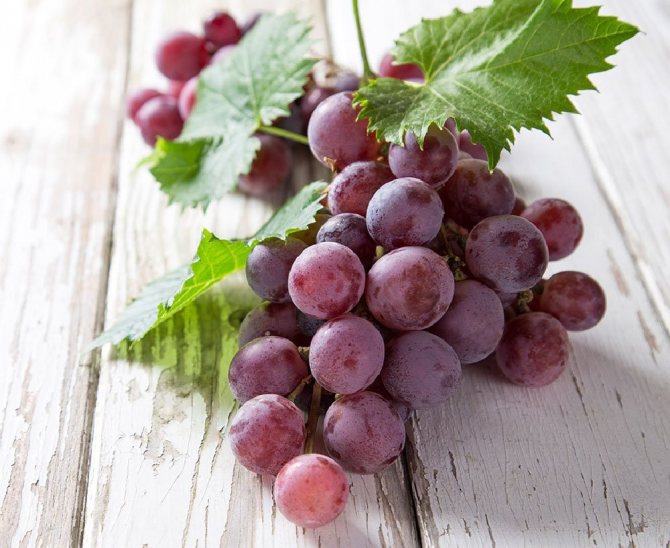

Rose grape varieties include varieties suitable for growing in the northern regions. Photo: sipsiphooraysite.files.
The author of the video talks about the features of the Gurzufsky variety, notes the unusual taste of the berries:
Diseases and pests
| Mildew Control measures:
|
| Grape itch Control measures:
|

